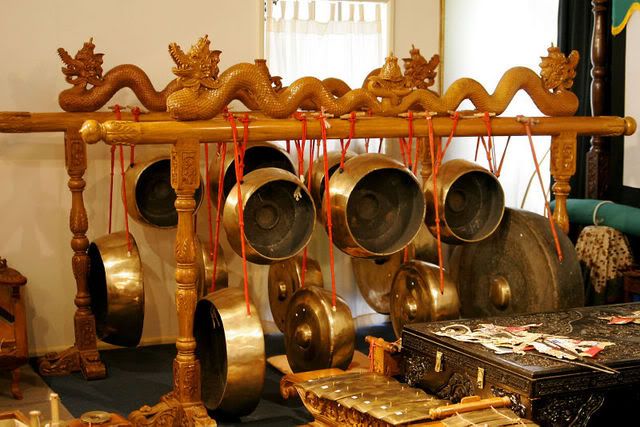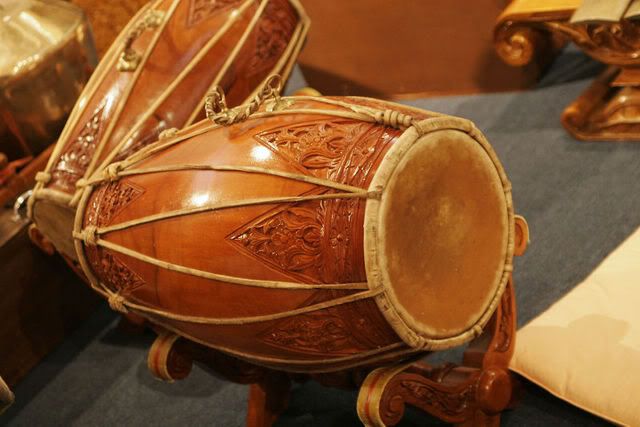|
|
|
A gamelan is a kind of musical ensemble of Indonesian origin typically featuring a variety of instruments such as metallophones, xylophones, drums, and gongs; bamboo flutes, bowed and plucked strings, and vocalists may also be included. The term refers more to the set of instruments than the players of those instruments. A gamelan as a set of instruments is a distinct entity, built and tuned to stay together |
Rate
-
1
View Rating Log
-
|
|
|
|
|
|
|
|
|
|
|
Instruments and characteristics
Gamelan are found in the Indonesian islands of Java, Madura, Bali, and Lombok (and other Sunda Islands), in a wide variety of ensemble sizes and formations. In Bali and Lombok today, and in Java through the 18th century, the term "gong" has been preferred to or synonymous with gamelan. Traditions of gamelan-like ensembles (sometimes called "gong-chime ensembles" by ethnomusicologists) also exist in the Philippines, Malaysia and Suriname, sometimes due to emigration, trade, or diplomacy. More recently, through immigration and local enthusiasm, gamelan ensembles have become active throughout Europe, The Americas, Asia, and Australia.
Although gamelan ensembles sometimes include solo and choral voices, plucked and/or bowed string and wind instruments, they are most notable for the large number of metal percussion instruments. A central Javanese gamelan ensemble includes:
|
|
|
|
|
|
|
|
|
|
|
|
Metals used include bronze, brass, and iron, with a 10:3 copper-to-tin bronze alloy usually considered the best material. In addition, there are gamelan ensembles composed entirely of bamboo-keyed instruments, of bamboo flutes, of zithers, or of unaccompanied voices with the functions of metallophones or gongs in the metal ensemble transferred to surrogates.
Gamelan music is built up in layers. At its centre is a basic melody (core melody) known as the balungan. Further layers, including singing in vocal pieces, elaborate upon this melody in certain ways, but the notes of each layer of music relate to the balungan, and generally coincide at the ends of phrases (called seleh in Javanese). There are also a set of instruments which delineate a colotomic structure, usually ending in the stroke of the largest gong.
 |
|
|
|
|
|
|
|
|
|
|
|
History
The gamelan has an old and mysterious origin. Apparently it predates the Hindu-Buddhist culture that dominated Indonesia in its earliest records, and instead represents a native art form. The instruments developed into their current form during the Majapahit Empire.[1] In contrast to the heavy Indian influence in other art forms, the only obvious Indian influence in gamelan music is in the Javanese style of singing.[2]
In Javanese mythology, the gamelan was created by Sang Hyang Guru in Saka era 167 (c. AD 230), the god who ruled as king of all Java from a palace on the Maendra mountains in Medangkamulan (now Mount Lawu). He needed a signal to summon the gods, and thus invented the gong. For more complex messages, he invented two other gongs, thus forming the original gamelan set.
In the palaces of Java are the oldest known ensembles, the Munggang and Kodokngorek gamelans, apparently from the 12th century. These formed the basis of a "loud style." A different, "soft style" developed out of the kemanak tradition and is related to the traditions of singing Javanese poetry, in a manner which is often believed to be similar to performance of modern bedhaya dance. In the 17th century, these loud and soft styles mixed, and to a large extent the variety of modern gamelan styles of Bali, Java, and Sunda resulted from different ways of mixing these elements. Thus, despite the seeming diversity of styles, many of the same theoretical concepts, instruments, and techniques are shared between the styles. |
|
|
|
|
|
|
|
|
|
|
|
Varieties of gamelan ensembles
There are a wide variety of gamelan ensembles, distinguished by their collection of instruments and use of voice, tunings, repertoire, style, and cultural context. In general, no two gamelan ensembles are the same, and those that arose in prestigious courts are often considered to have their own style. Certain styles may also be shared by nearby ensembles, leading to a regional style.
The varieties are generally grouped geographically, with the principal division between the styles favored by the Balinese, Javanese, and Sundanese peoples. Balinese gamelan is often associated with the virtuosity and rapid changes of tempo and dynamics of Gamelan gong kebyar, its best-known style. Other popular Balinese styles include Gamelan angklung and kecak, also known as the "monkey chant." Javanese gamelan was largely dominated by the courts of the 19th century central Javanese rulers, each with its own style, but overall is known for a slower, more meditative style than that of Bali.
Outside of the main core on Java and Bali, gamelans have spread through migration and cultural interest, and while sometimes the original styles are copied, new styles sometimes result as well. Malay gamelans are designed in ways that are similar to the Javanese gamelan except that the tune is higher. The gamelans were traditionally played in the royal Malay palaces of Pahang (Gamelan Pahang), Riau, Kedah, Kelantan and Terengganu. Gamelan is also related to the Philippine kulintang ensemble. There is also a wide variety of gamelan in the West, including both traditional and experimental ensembles. See gamelan outside Indonesia for more information on these styles.
 |
|
|
|
|
|
|
|
|
|
|
|
Kulintang
Kulintang is a modern term for an instrumental form of music composed on a row of small, horizontally-laid gongs that function melodically, accompanied by larger, suspended gongs and drums. As part of the larger gong-chime culture of Southeast Asia, kulintang music ensembles have been playing for centuries in regions of the Eastern Malay Archipelago |
|
|
|
|
|
|
|
|
|
|
|
Geographic extent
Kulintang belongs to the larger unit/stratum of 搆nobbed gong-chime culture |
|
|
|
|
|
|
|
|
|
|
|
kekadang terpikir jugak nak cuba main muzik gamelan nih.....
nak buat lagu P ramlee jangan tinggal daku.....
boleh tak agaknyer erk............ |
|
|
|
|
|
|
|
|
|
|
|
|
gamelan ni sama ker muzik mak yong..konfius aar:stp: |
|
|
|
|
|
|
|
|
|
|
|
Mak Yong adalah seni teater tradisional masyarakat Melayu yang sampai sekarang masih digemari dan sering dipertunjukkan sebagai dramatari dalam forum internasional. Di zaman dulu, pertunjukan mak yong diadakan orang desa di pematang sawah selesai panen padi.
Dramatari mak yong dipertunjukkan di negara bagian Terengganu, Pattani, Kelantan, dan Kedah. Selain itu, mak yong juga dipentaskan di Kepulauan Riau Indonesia. Di kepulauan Riau, mak yong dibawakan penari yang memakai topeng, berbeda dengan di Malaysia yang tanpa topeng.
Pertunjukan mak yong dibawakan kelompok penari dan pemusik profesional yang menggabungkan berbagai unsur upacara keagamaan, sandiwara, tari, musik dengan vokal atau instrumental, dan naskah yang sederhana. Tokoh utama pria dan wanita keduanya dibawakan oleh penari wanita. Tokoh-tokoh lain yang muncul dalam cerita misalnya pelawak, dewa, jin, pegawai istana, dan binatang. Pertunjukan mak yong diiringi alat musik seperti rebab, gendang, dan tetawak. |
Rate
-
1
View Rating Log
-
|
|
|
|
|
|
|
|
|
|
|
|
Mana ada kelas mengajar bermain gamelan ni?.. |
|
|
|
|
|
|
|
|
|
|
|
Reply #11 stripper_j's post
|
dilla rasa dekat UKM ada balai seninmuzik gamelan nih.........:hmm: |
|
|
|
|
|
|
|
|
|
|
|
Reply #11 stripper_j's post
Setau Fiza ler ader kat UIA, UKM....yg lain tak tau
Dulu time study ...ingat nak belajar gamelan....cam best jer.
Tp application dah penuh sbb ramai yg nak belajar. Dan diorg amik sedikit jer ahli.
So terbatal la niat ku nak belajar gamelan |
|
|
|
|
|
|
|
|
|
|
|
Rasanya setiap uni ada pasukan gamelan.
Dan sekiranya nak belajar, ASK (sekarang ASWARA) ada menyediakan kelas belajar main gamelan.
harap membantu.  |
|
|
|
|
|
|
|
|
|
|
|
Reply #14 x-tra's post
|
tapi aku dah check kat website dia...tkde pulak utk kelas gamelan ni...aswara cuma tawarkan diploma...mungkin kat website dia tkde kot... kite kena call dulu...:hmm: :hmm: |
|
|
|
|
|
|
|
|
|
|
|
captain,
hmmmm...dulu ada dia bgtau kat site (masa ASK) pasal short course....sbb ada member 2-3 org amik kursus gamelan.
bila dah naik taraf ke ASWARA takde dia masukkan kan dalam site pasal short course yek... :hmm:
kena call dulu kot....
|
|
|
|
|
|
|
|
|
|
|
|
Originally posted by x-tra at 9-5-2007 04:28 PM
captain,
hmmmm...dulu ada dia bgtau kat site (masa ASK) pasal short course....sbb ada member 2-3 org amik kursus gamelan.
bila dah naik taraf ke ASWARA takde dia masukkan kan dalam site ...
x-tra pun minat gak ker main gamelan ni??? |
|
|
|
|
|
|
|
|
|
|
|
minat.....
dan pernah main masa blajo kat uni dulu....
tu yg gian masih ada walaupun dah lama tak main...
antara lagu yg selalu main :- Lambang sari, timang burung dengan ikan kekek...
 |
|
|
|
|
|
|
|
|
|
|
|
Originally posted by x-tra at 23-5-2007 12:39 PM
minat.....
dan pernah main masa blajo kat uni dulu....
tu yg gian masih ada walaupun dah lama tak main...
antara lagu yg selalu main :- Lambang sari, timang burung dengan ikan kekek...

masa kat uni dulu tkder masa nk join kelas...selalu gi tgk jer kalo ada show...
aku sgt2 suke ngan alunan muzik.... x-bf aku join group muzik utk gamelan ni...
selalu gak dia buat show kat hotel2 n kenduri kawin....
kdg2 kalo nak release tension....aku dgr jer cd gamelan ni...... skrg ni hobi baru aku..selain kumpul muzik gamelan ni dari malaysia..aku tgh kumpul muzik2 gamelan dari Indonesia dan Singapore... kalo ko berminat nanti pm aku... |
|
|
|
|
|
|
|
|
|
|
|
ooo seminat la kita nih yek...hehehehe
hmmm...boleh jugak kalo dapat share tu...tapi nanti la...pc kat sini skrg tgh demam virus....nnt takut terdelete nangih lak...
apapun...harap ramai lagi suka irama gamelan yg gemalai dan menenangkan jiwa  |
|
|
|
|
|
|
|
|
|
| |
Category: Belia & Informasi
|